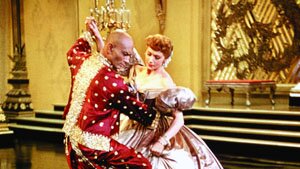Directed by Walter Lang
Loosely based on the story of Anna Leonowens, a British woman who goes to the royal court of Siam to teach in the 1860’s, The King and I is a Rogers and Hammerstein musical turned into a 1956 Academy Award winning movie.
As it turned out, Yul Brynner (who won Best Actor) would turn the musical into a career playing the lead male role onstage for a gazillion years.
The movie is a lovely, colourful confection. It’s a fairy tale and works brilliantly as such.
As a fairy tale, it’s not particularly realistic but on its own terms its marvellous. The King and I is plainly romance. You can see the relationship building between Anna and the King, you can see why they would be attracted to one another, and you can see the cultural, social and political barriers that they must overcome.
Deborah Kerr as Anna Leonowens and Yul Brynner as King Mongkut of Siam.
(Contrast the chemistry between Brynner and Deborah Kerr with that between Brynner and Ingrid Bergman in Anastasia. In the former it works; in the latter it is completely absent, which is why The King and I convinces and Anastasia does not.)
You can see why Brynner was asked to reprise the role onstage over and over. He fits the part perfectly with his “not quite sure where that accent is from” non-Western look and speech. He doesn’t necessarily look or sound Asian … but he could be.
Deborah Kerr, for her part, fits the role of Anna well too. She has the look and the appropriate reserve mixed with confidence of a mid-nineteenth century British woman.
Anna (Deborah Kerr) and the King (Yul Brynner).
It’s an engaging, light film but doesn’t completely work. Some scenes go on far too long largely due, I think, to the fact it’s a musical and they are trying too hard to get the musical on film.
For example, there is the presentation of the Princess’ Siamese adaptation of Uncle Tom’s Cabin. It seems endless. While you can see how it might work on stage, on film it simply bogs everything down.
This is unfortunate because what works best about the film are its cinematic aspects. For the most part, it emphasizes its story, dropping in musical numbers here and there but not excessively.
We get to see and become involved with the growing relationship between Anna and the King because the story takes precedence over the music. It is shot and presented as a movie, not as a musical put on film. It’s only when the film stops and decides to be a filmed musical that it comes to a halt.
One of the truly delightful aspects of the movie is its use of colour. It is brilliant and exuberant. The sets are lavish. The scenes and settings change colours almost like a kaleidoscope.

The King and Anna dance.
It’s a joyful use of colour and as I watched it I couldn’t help thinking that something in the use of colour has been lost in many contemporary films where colour is used in a more desaturated, almost monochromatic way, often tinted a predominant colour for the purposes of subtext and meaning.
In The King and I colour exists simply for its visual impact. It’s meaning, if it has any, is simply, “This is a colourful place. Look how colourful it is!”
Again, the most appropriate term for how it is used is ‘exuberant.’
The DVD presentation of The King and I is excellent. (Note: refers to 1999 20th Century Fox edition.) It captures the colours and gives us a clean image, as well as pretty good sound. Overall, it’s a wonderful movie. For me, it’s one of the better musicals – not in terms of musicals but in terms of film because, with some exceptions, it favours the story over the music.


